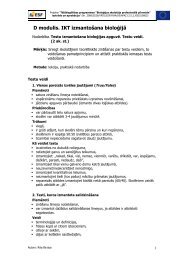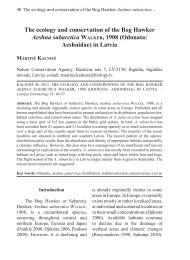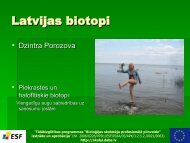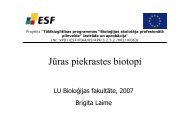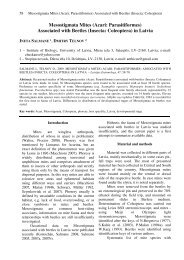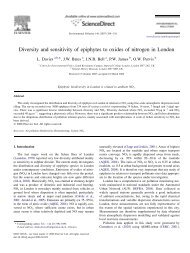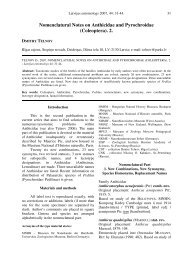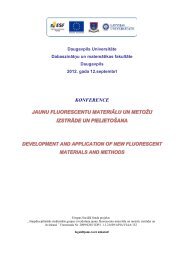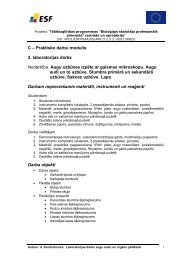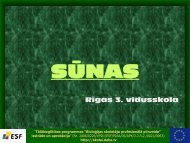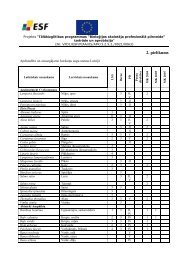Odonata - Entomological Society of Latvia - Latvijas Daba
Odonata - Entomological Society of Latvia - Latvijas Daba
Odonata - Entomological Society of Latvia - Latvijas Daba
You also want an ePaper? Increase the reach of your titles
YUMPU automatically turns print PDFs into web optimized ePapers that Google loves.
habitats <strong>of</strong> open or wooded bogs. According to Pajunen (1962), Leucorrhinia dubia males and<br />
females stay away from water during the prereproductive period and gather at the breeding waters<br />
and their immediate surroundings for mating and oviposition. TWINSPAN analysis identified<br />
Lestes sponsa and Leucorrhinia albifrons as indicator species <strong>of</strong> wet habitats. These species prefer<br />
to stay at shores <strong>of</strong> water bodies and above the water. The groups separated by occurrence <strong>of</strong> Anax<br />
imperator and Aeshna grandis were too small (three and two sampling plots) to allow to make<br />
conclusions.<br />
4.3. THE OCCURENCE AND POPULATION DENSITY OF GOMHIDAE LARVAE IN RIVER GAUJA<br />
Distribution From the four species <strong>of</strong> Gomphidae family three were found in the research<br />
near the Gauja River – Gomphus vulgatissimus, Onychogomphus forcipatus and Ophiogomphus<br />
cecilia. The most widespread species was Gomphus vulgatissimus. Although, Gomphus flavipes<br />
was not found in the course <strong>of</strong> research, based on the literature data (Спурис 1956), this species has<br />
been registered near the Gauja River. This may be explained by the fact that the species is mostly<br />
found near large rivers and only found in the lower Gauja (Спурис 1956). It is possible that the<br />
species is less numerous than other Gomphidae species. In literature it is noted that large<br />
populations appear only near large rivers (Dijkstra 2006; Bernard et al. 2009). In <strong>Latvia</strong><br />
G. vulgatissimus is a widespread species, while O. forcipatus is moderately spread. Both species<br />
can be found near the Gauja River and it is most likely due to the presence <strong>of</strong> various micro habitat<br />
substrates along the river. O. forcipatus is less <strong>of</strong>ten found in the middle and lower Gauja due to the<br />
gradual decrease <strong>of</strong> swift and rocky stretches in the direction from the upper to the lower Gauja<br />
(Avotiņa 1995; Kalniņš, Urtāns 2007). Based on the larvae data, O. cecilia is rarely found in the<br />
Gauja River, however, when combining all available (including literature) data on larvae<br />
observations and on imago observations, there are significant differences in the distribution <strong>of</strong><br />
O. cecilia. The larvae in the Gauja River were found only in five locations, but adult individuals<br />
were observed almost throughout the river (in 23 squares). It is likely to indicate low density <strong>of</strong><br />
larvae, as several authors note that O. cecilia is a physiologically and ecologically flexible species<br />
(Suhling 1994; Müller 2002) and populates also specific habitats like the surfaces <strong>of</strong> large rocks<br />
(Müller 2004).<br />
Occurrence The most frequently represented in the samples were the G. vulgatissimus<br />
larvae, while the best represented substrates were sand, gravel and mud. The occurrence <strong>of</strong> the<br />
species depends on various abiotic and biotic factors (Korkeamäki, Suhonen 2002). During the<br />
research the effect <strong>of</strong> the riverbed substrate was analysed. Gomphidae larvae are common for ritral<br />
rivers with no or scarce vegetation (Müller 2002). The micro habitate substrate components found<br />
in the sample are characteristic to the freshwater habitat types represented in the Gauja River<br />
(Kalniņš, Urtāns 2007). When comparing the substrate distribution in the Gomphidae samples and<br />
in all samples, several differences were found (Figure 9). In Gomphidae samples the proportion <strong>of</strong><br />
pebbles and rocks is larger, which accounts for the presence <strong>of</strong> O. forcipatus, as, individually<br />
analysing G. vulgatissimus and O. forcipatus, a distinct relation <strong>of</strong> O. forcipatus with pebble and<br />
stone riverbeds in rapid river sections was found (Figure 10). When comparing the habitat<br />
descriptions given by different authors (Table 7), it is evident that most frequently noted is the size<br />
<strong>of</strong> the river, less popular habitats or substrates populated by larvae. While the literature accounts<br />
(Спурис 1956; Askew 1988; Spuris 1993) are generally concurrent with the results <strong>of</strong> the research,<br />
they are based on imago observations, which do not allow the evaluation <strong>of</strong> the importance <strong>of</strong><br />
specific habitats and substrates. For example, O. cecilia in the locations in the Gauja River and<br />
other water courses, where larvae have been found (Kalniņš, Inberga-Petrovska 2005), a thin layer<br />
(1-2 cm) <strong>of</strong> mud above sand was found (including the sites, where the qualitative samples were<br />
collected). Apparently, mud is an important component <strong>of</strong> the substrate <strong>of</strong> larvae habitats; however,<br />
with accumulation <strong>of</strong> mud, the habitat is no longer suited for the species (Müller 2002). The<br />
identification <strong>of</strong> O. cecilia larvae in two (out <strong>of</strong> 280) samples indicates the rarity <strong>of</strong> the species. The<br />
occurrence analysis shows that the species are not found in all seemingly suitable habitats and there<br />
are additional limitations.<br />
71



